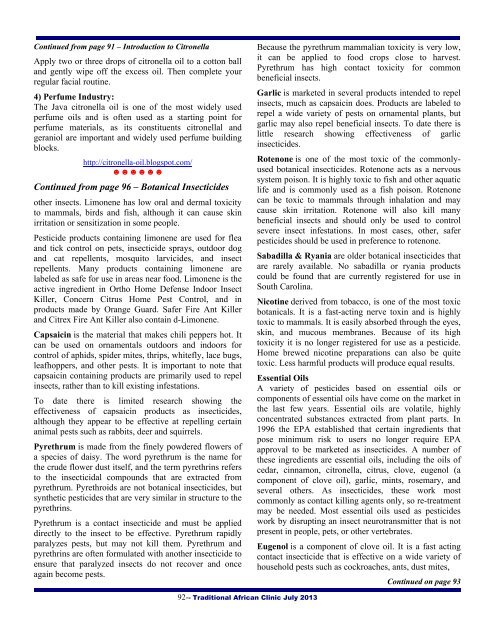toxicity - pesticides, herbicides and insecticides - Blackherbals.com
toxicity - pesticides, herbicides and insecticides - Blackherbals.com
toxicity - pesticides, herbicides and insecticides - Blackherbals.com
Create successful ePaper yourself
Turn your PDF publications into a flip-book with our unique Google optimized e-Paper software.
Continued from page 91 – Introduction to CitronellaApply two or three drops of citronella oil to a cotton ball<strong>and</strong> gently wipe off the excess oil. Then <strong>com</strong>plete yourregular facial routine.4) Perfume Industry:The Java citronella oil is one of the most widely usedperfume oils <strong>and</strong> is often used as a starting point forperfume materials, as its constituents citronellal <strong>and</strong>geraniol are important <strong>and</strong> widely used perfume buildingblocks.http://citronella-oil.blogspot.<strong>com</strong>/☻☻☻☻☻☻Continued from page 96 – Botanical Insecticidesother insects. Limonene has low oral <strong>and</strong> dermal <strong>toxicity</strong>to mammals, birds <strong>and</strong> fish, although it can cause skinirritation or sensitization in some people.Pesticide products containing limonene are used for flea<strong>and</strong> tick control on pets, insecticide sprays, outdoor dog<strong>and</strong> cat repellents, mosquito larvicides, <strong>and</strong> insectrepellents. Many products containing limonene arelabeled as safe for use in areas near food. Limonene is theactive ingredient in Ortho Home Defense Indoor InsectKiller, Concern Citrus Home Pest Control, <strong>and</strong> inproducts made by Orange Guard. Safer Fire Ant Killer<strong>and</strong> Citrex Fire Ant Killer also contain d-Limonene.Capsaicin is the material that makes chili peppers hot. Itcan be used on ornamentals outdoors <strong>and</strong> indoors forcontrol of aphids, spider mites, thrips, whitefly, lace bugs,leafhoppers, <strong>and</strong> other pests. It is important to note thatcapsaicin containing products are primarily used to repelinsects, rather than to kill existing infestations.To date there is limited research showing theeffectiveness of capsaicin products as <strong>insecticides</strong>,although they appear to be effective at repelling certainanimal pests such as rabbits, deer <strong>and</strong> squirrels.Pyrethrum is made from the finely powdered flowers ofa species of daisy. The word pyrethrum is the name forthe crude flower dust itself, <strong>and</strong> the term pyrethrins refersto the insecticidal <strong>com</strong>pounds that are extracted frompyrethrum. Pyrethroids are not botanical <strong>insecticides</strong>, butsynthetic <strong>pesticides</strong> that are very similar in structure to thepyrethrins.Pyrethrum is a contact insecticide <strong>and</strong> must be applieddirectly to the insect to be effective. Pyrethrum rapidlyparalyzes pests, but may not kill them. Pyrethrum <strong>and</strong>pyrethrins are often formulated with another insecticide toensure that paralyzed insects do not recover <strong>and</strong> onceagain be<strong>com</strong>e pests.Because the pyrethrum mammalian <strong>toxicity</strong> is very low,it can be applied to food crops close to harvest.Pyrethrum has high contact <strong>toxicity</strong> for <strong>com</strong>monbeneficial insects.Garlic is marketed in several products intended to repelinsects, much as capsaicin does. Products are labeled torepel a wide variety of pests on ornamental plants, butgarlic may also repel beneficial insects. To date there islittle research showing effectiveness of garlic<strong>insecticides</strong>.Rotenone is one of the most toxic of the <strong>com</strong>monlyusedbotanical <strong>insecticides</strong>. Rotenone acts as a nervoussystem poison. It is highly toxic to fish <strong>and</strong> other aquaticlife <strong>and</strong> is <strong>com</strong>monly used as a fish poison. Rotenonecan be toxic to mammals through inhalation <strong>and</strong> maycause skin irritation. Rotenone will also kill manybeneficial insects <strong>and</strong> should only be used to controlsevere insect infestations. In most cases, other, safer<strong>pesticides</strong> should be used in preference to rotenone.Sabadilla & Ryania are older botanical <strong>insecticides</strong> thatare rarely available. No sabadilla or ryania productscould be found that are currently registered for use inSouth Carolina.Nicotine derived from tobacco, is one of the most toxicbotanicals. It is a fast-acting nerve toxin <strong>and</strong> is highlytoxic to mammals. It is easily absorbed through the eyes,skin, <strong>and</strong> mucous membranes. Because of its high<strong>toxicity</strong> it is no longer registered for use as a pesticide.Home brewed nicotine preparations can also be quitetoxic. Less harmful products will produce equal results.Essential OilsA variety of <strong>pesticides</strong> based on essential oils or<strong>com</strong>ponents of essential oils have <strong>com</strong>e on the market inthe last few years. Essential oils are volatile, highlyconcentrated substances extracted from plant parts. In1996 the EPA established that certain ingredients thatpose minimum risk to users no longer require EPAapproval to be marketed as <strong>insecticides</strong>. A number ofthese ingredients are essential oils, including the oils ofcedar, cinnamon, citronella, citrus, clove, eugenol (a<strong>com</strong>ponent of clove oil), garlic, mints, rosemary, <strong>and</strong>several others. As <strong>insecticides</strong>, these work most<strong>com</strong>monly as contact killing agents only, so re-treatmentmay be needed. Most essential oils used as <strong>pesticides</strong>work by disrupting an insect neurotransmitter that is notpresent in people, pets, or other vertebrates.Eugenol is a <strong>com</strong>ponent of clove oil. It is a fast actingcontact insecticide that is effective on a wide variety ofhousehold pests such as cockroaches, ants, dust mites,Continued on page 9392-- Traditional African Clinic July 2013
















